Speech The Australian Economy

Stephen Grenville
Deputy Governor
Notes For Talk To ABN AMRO Australia Day Conference
Tokyo –
After nine years of excellent growth, the Australian national accounts recorded a fall in the December quarter. I want to put this in context, saying something about what happened and what it might mean for the future. Australia's record of growth in the 1990s was not a fluke or coincidence – it was a result of good fundamentals: that has not changed, and so our prospects are still good.
What Happened?
With the benefit of hindsight, the fall in the December quarter might be seen this way:
- in the first half of the year, there was an upsurge in residential construction, with a very substantial ‘pull forward’ of work to avoid the GST. This ‘pull forward’, mechanically, left a big hole in the second half of the year;
- in a low inflation world – where producers pass on price increases only with some trepidation – the threefold sources of pressure on prices (GST, exchange rate and oil) squeezed cash-flows and profits. When this is combined with the disruption and general choler associated with the introduction of the new tax regime, small and medium business confidence took a hit;
- policy settings operated in an environment where cost-push price pressures were very strong.
Let me say a bit more about each of these aspects – the cause of the GDP fall; the short-term temporary shocks which the economy experienced in the second half of 2000; and the stance of policy.
(a) The construction sector
It may seem improbable that a sector accounting for only 5 per cent of the economy should bulk so large in this story. So I will have to ask your patience while I give the detail.
Residential construction was, even without the GST, reaching the mature phase of its usual cycle as the economy entered 2000. Such was the frenzy to get construction done before the GST, that avoiding the tax became an end in itself: people were paying more than 10 per cent extra in order to attempt to complete work ahead of a 10 per cent tax. We heard few complaints from the construction sector, but many stories of seven-day working weeks and very significant pressures on construction contract prices, as builders attempted to ration the demands on their capacity. It was to be expected – indeed it was inevitable – that this frenzy had to end in the second half of the year, with the reversal coinciding with what was probably the natural inflection-point of the building cycle. This conjuncture gave rise to the sharpest quarterly fall in housing activity ever recorded in the Australian statistics (and the largest half-yearly fall too – by a large margin). Overall, the September quarter was hard to evaluate, because of the effect of the Olympics – where sports-crazed fans added to demand by spending their money on getting to the Games, and subtracted from it by staying at home to watch on TV. If we take out dwellings and a crude adjustment for the Olympics, we note that the remaining 95 per cent of the economy was growing at a rate of a little under 4 per cent through 2000 (in fact, a little faster in the second half than in the first).
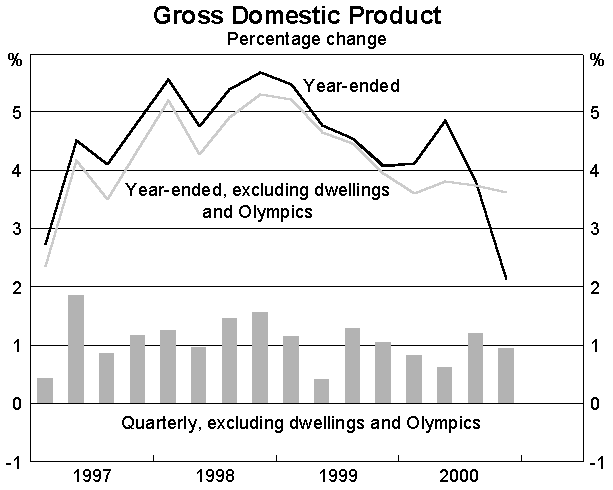
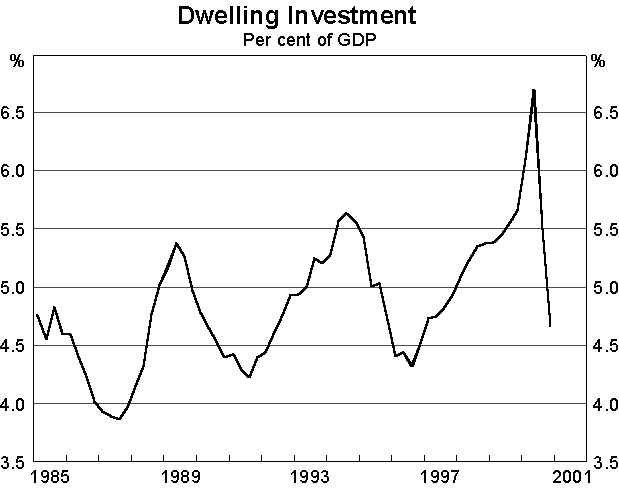
You might say that the profile of residential construction should have been predicted (and in its broad outline was certainly foreseen). What was not foreseen was, first, the size of this fall and, second, the degree of confidence-sapping annoyance with the administration of the GST. The basic point here is clear: without the ‘tail’ of the construction sector wagging the dog of GDP, any slowdown would have been moderate, thus continuing the economic performance of the 1990s.
(b) Cost pressures
Business confidence, particularly that of small businesses, was falling well before the GDP figures were made public. Part of this was clearly related to the decline in the housing sector and part to difficulties which small business was having in adapting to the administration of the GST. But, by January 2001, there was another piece of data pointing to an additional factor. Paradoxically, it was the unexpectedly good performance of the CPI in the December quarter. The second half of the year had seen three strong cost-push inflationary pressures – the GST adding 10 per cent to many prices; an exchange rate which had fallen 15 per cent over the first ten months of 2000; and a world petroleum price which was 87 per cent higher (in terms of Australian dollars) than eighteen months earlier. The cost-push pressures from oil and the exchange rate were showing quite clearly in producer prices, with input prices for manufacturing rising by almost 20 per cent during the calendar year. Faced with these cost pressures, it looks as though many producers (particularly in manufacturing) found it difficult or impossible to pass on these price increases quickly, particularly in an environment where low inflation was well established, competition was vigorous and there was a fair bit of ‘moral suasion’. Quantifying this price squeeze is quite difficult, and assessing its role in the slowdown more difficult still, because the starting point of profits was so strong. And, of course, there were some sectors (notably exports) where profits were substantially boosted by the lower exchange rate. But there is little doubt that some businesses felt squeezed, and this had a general dampening effect on their animal spirits.
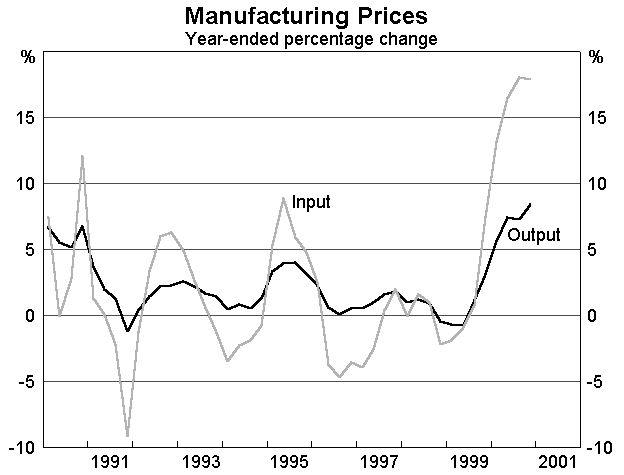
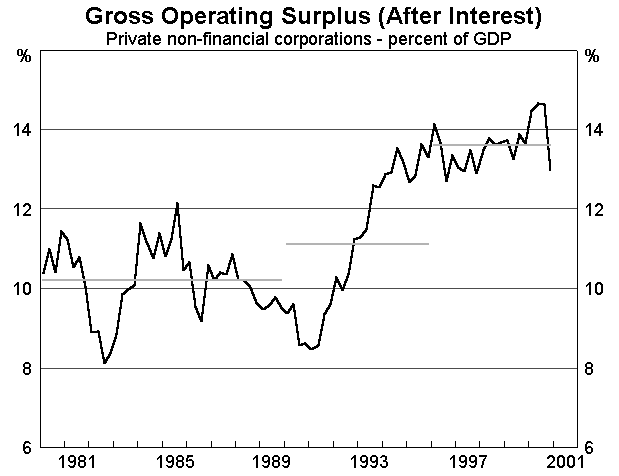
(c) Policy setting
It is hard to argue that the downturn was caused by tight macro-policy settings. The GST was accompanied by a reduction in income tax which was designed to be larger than the GST effect – i.e. there was over-compensation for the GST. While the budget continued to show a surplus, it was a surplus smaller than the previous year, which in macro-policy terms is expansionary. Official interest rates were raised by 150 basis points between November 1999 and August 2000, starting from a low point established during the Asian economic crisis. Not only is it hard to believe that monetary policy is anything like that powerful (particularly as the last of the increases – in August – had so little time to have effect), but the proximate cause of the sharp slowing is clearly found elsewhere. This is not to claim that monetary policy has no effect on the economy – I am hardly going to do that. But it is to assert that – with lending rates lower (in nominal and real terms) at their recent peak than at the low point of the mid 1990s and with demand for credit still strong at these interest rates – the setting of monetary policy cannot be seen as a principal actor.
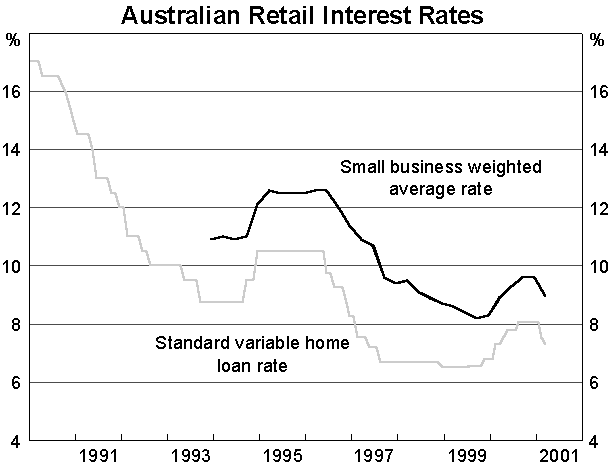
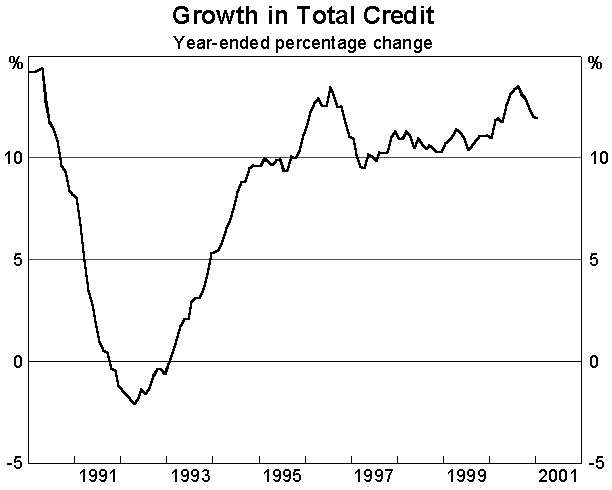
Could the economy have successfully negotiated the period of robust growth, and rising inflation, in the first half of 2000, in the face of strong downward pressure on the exchange rate, with interest rates maintained at 4¾ per cent? That setting would, of course, have been well below the United States and we would have been the only country in the developed world not to raise interest rates. The policy environment in the second half of 2000 was no easier. Among the three price shocks (GST, exchange rate and oil prices), only the last was a pure textbook ‘supply-side’ shock. But, together, they had many of the same characteristics – cost-push pressures on prices. As it became clear, with the CPI result in January, that these cost pressures were well contained, policy responded quickly and half the increase has been reversed.
Why was it Unexpected?
One answer would be to acknowledge the imprecision of forecasts – one of the few certainties of forecasting is that outcomes will differ from forecasts. After a lifetime of observing the economy, a sage concluded that ‘nothing is certain; anything is possible; and everything depends on everything else’. And of course this is part of the story. But a powerful element in this story is simply that the economic fundamentals were (and are) so good, that it is still, even now, hard to accept that an economy without imbalances, which has capacity to grow further, and with accommodative policy settings should change direction so suddenly.
Contrast the state of the economy in 2000 with the history of post-WWII cycles. The grand, if depressing, tradition was that Australian expansions came to a halt either because they ran into an external constraint (in the pre-1984 world, a current account crisis), or because there was a wages/inflation break-out. Policy could not offset these imbalances in a subtle or gentle way, so strong use of the policy levers was often also ‘present at the scene of the crime’. Hence the characterisation of policy as ‘stop/go’. How different was the world of 2000: an improving external position (improving, uncharacteristically, despite good growth); inflation well contained both currently and in prospect (reflected in bond yields, where the $A bond yield has remained just a few tenths of a per cent higher than the US$ bond); wages growing at a moderate pace; a budget continuing in surplus but nevertheless able to provide offset to the GST and overall macro stimulus. Moreover, the economy itself was in good shape. Fifteen years of reform (on tariffs, privatisation, labour market, competition and policy framework) had produced productivity growth during the nine-year expansion of the 1990s better, even, than the much-vaunted US performance. Productivity brought with it the virtuous circle of strong profits and non-inflationary real wage increases: there were none of the factor-share imbalances that hobbled growth in the 1970s.
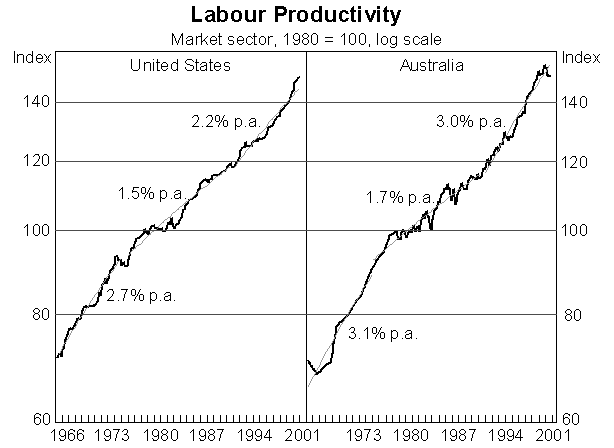
One further point is worth making. The main criticism of the Australian economy during 2000 was that we were an ‘Old’ economy, unfavourably contrasting with the ‘New’ economy populated by companies which worked exclusively in the ethereal world of cyberspace. A procession of foreign business luminaries visited Australia last year (curiously, those who came extolling the virtues of the virtual economy still found old-fashioned enjoyment in watching the Olympics in the flesh) to promote their companies, advising us to ignore our comparative advantage by following their example. We argued that the application of the new technology was where the productivity benefits would lie, and that Australia was on the forefront in exploiting these — and we had the runs on the board to prove it. But this was lost in the paeans of praise and thunderous applause for the stars of the cyberworld. How a year of collapsing NASDAQ can change perceptions! As Warren Buffett has observed: ‘nothing sedates rationality like large doses of effortless money’, but eventually reality returns. The productivity-enhanced Old Economy is looking rather better (would we want to be competing with Korea and Taiwan to produce computer chips, whose price is falling even faster than the NASDAQ?). It was Buffett who reminded us all, several years ago, that being ‘first mover’ in a vast and exciting new industry was not a guarantee of success or profits: history records the low survivorship among the pioneer firms in automobiles and aircraft. This is not to deny the enormous benefits of the new technology — just to observe that in history it has been the users of the technology, rather than the producers, who have benefited most. Just as Buffett's Berkshire Hathaway has returned to favour following several years in the wilderness (having recently bought into such unfashionable industries as boots, brick-making, carpet-manufacture and insulation), so too the tide of opinion may turn on Australia's product mix.
Despite the longevity of the expansion, the imbalances which normally characterise the mature phase of the cycle are not present in Australia. I can make this point more vividly by contrasting the Australian position with that of the United States, where there is a renewed interest in the ‘trade cycle’ analysis which, in the immediate post-WWII decades, dominated short-term economic commentary. Its characteristics were:
- an inventory cycle, where there was over-production during the upswing to meet growing inventory needs, followed by an exacerbation of the downturn as inventories adjusted in the opposite direction;
- an investment boom which uses up all the best investment opportunities and whose euphoria drives investment into marginally profitable projects;
- related to this, funding (particularly equity finance) which had been liberally given in the early phase of the cycle dries up as the financial sector comes to recognise the degree of over-commitment and attempts to compensate (or over-compensate) for this;
- asset prices, driven up by over-optimism about profit potential, spill over into investment decisions;
- households, buoyed by rising asset prices and the general euphoria, run down their savings, leaving them vulnerable to a sudden change in confidence.
All this jerky dynamic seems very relevant to America, and inapplicable to Australia. Let's contrast the cyclical position in the two countries.
First and foremost is the contrast between the share markets. With no NASDAQ bubble, the Australian equity market has continued to increase steadily throughout the period, and is currently still close to its peak, contrasting to, say, the Wilshire which is nearly 30 per cent below. Australia has no stories of 14-year-old boy-millionaires who ramped their chosen shares via a chat-room canard: nor, more substantively, of entrepreneurs with backwards-facing baseball caps attracting serious funding on the promise of a rapid ‘cash-burn’. So we didn't get the same degree of distorted investment decisions and ephemeral wealth-driven consumption.
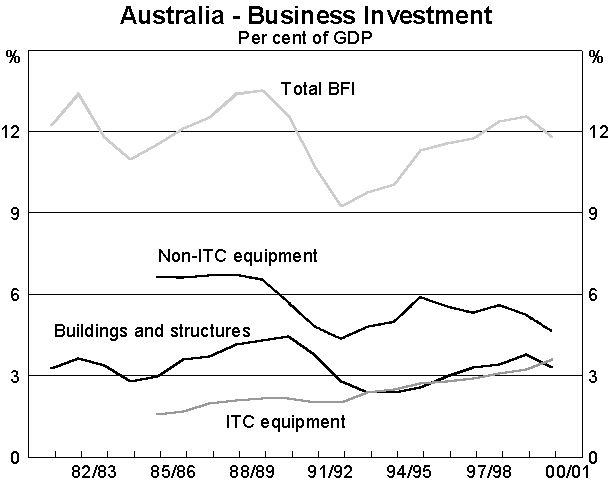
Business fixed investment expanded rapidly in America during the 1990s, to well above its historical average. Investment in information technology and communications equipment surged, with capacity to produce this equipment expanding by 50 per cent in the past year alone. In contrast, in Australia business investment has trended upwards during much of the 1990s, but in recent years has fallen back a little, to remain around its long-term average. There is in no sense a problem of over-investment. Slow but steady wins the race. Similarly, Australian household saving has not followed the American example into negative territory.
The US financial sector is showing all the signs of concern about rising risks and lowering profit expectations in the business sector. Spreads between yields on US Treasury securities and corporate bonds have widened noticeably. The data on IPOs shows that it became increasingly difficult during the year to get these away. Commercial banks became more cautious in their lending, particularly after the large amounts they had directed to Telecom companies. By contrast, in Australia there has been no noticeable widening of risk spreads in the corporate bond market over the past year, and credit has been easily available from intermediaries, with no reports of significant changes in banks' lending attitudes. The financial sector itself is in good shape.
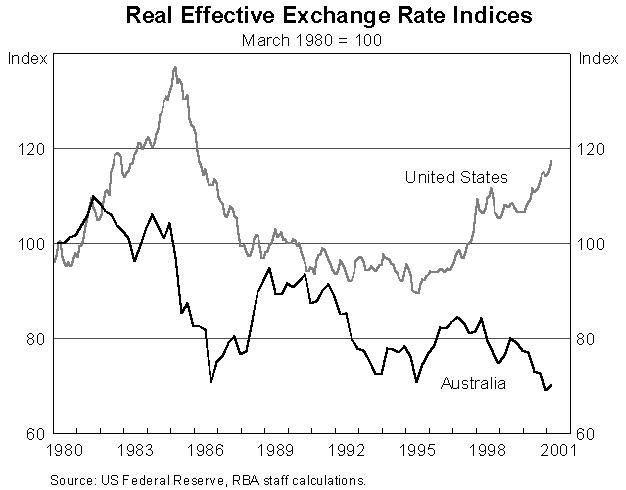
One of the more interesting contrasts is with the exchange rate. The normal cyclical response of exchange rates is to strengthen in the face of economic expansion. So it was not surprising to see the strength of the US dollar over recent years — only that it has continued to strengthen in the face of a growing perception of a likely slowing. Given that the evidence of the early 1980s pointed to a two-year lag between exchange rates and their effect on activity in the United States, an exchange rate well above its average of the past decade would not seem to provide much protection in the face of a slowing. The Australian dollar, in contrast, has been low in real effective terms, providing a useful buffering in the face of a slower world economy, as was demonstrated during the 1998 Asian economic crisis.
Looking Ahead
Just as the events of the second half of last year look clearer in hindsight, we doubtless have more to learn about this period, and may well need to add to our current interpretation. But if this analysis is correct, then the events so far would point to a relatively short-lived slowing. As the temporary once-off effects of GST, construction ‘pull forward’, the Olympics and the threefold price pressures pass through the system, the fundamental health of the economy can reassert itself. This is all the more so because the economy has two significant forces of stimulus working on it – the Budget and a very competitive exchange rate. Let me say more about these two issues.
I can recall, some years ago, Larry Summers talking very positively about America having ‘reloaded the fiscal cannon’ – with the clear implication that it was ready, primed and could be used if necessary for fiscal policy to take its role in supporting activity. The same is clearly the case in Australia, where several years of good surpluses have created the opportunity to provide macro stimulus while maintaining the longer-term credentials of fiscal responsibility.
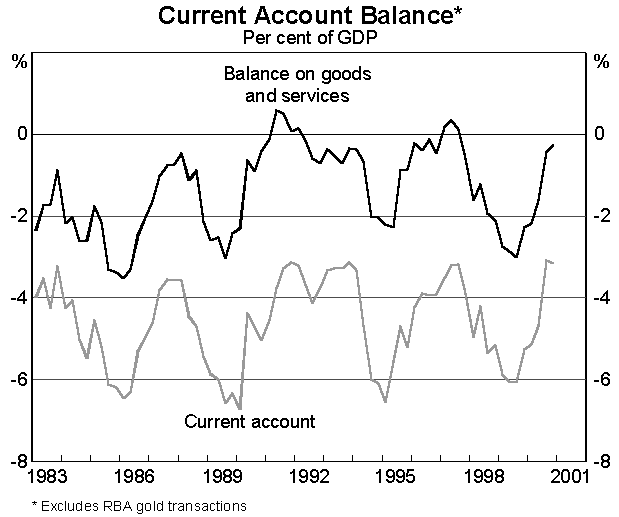
The second clear form of macro stimulus comes from the super-competitive exchange rate. Central banks are always uncomfortable with a weakening exchange rate, and there have certainly been moments of great discomfort over the past year. But, as usual in economics, it's an ill wind that blows nobody any good – the super-competitive exchange rate is a sure form of stimulus for the economy, and while there are (as usual) lags in its operation – particularly on the export side – there is little doubt that it is a powerful effect. This is already showing on imports and exports (where non-rural exports are up 12 per cent in volume terms over 2000), and in a current account deficit which is running at a little over 3 per cent of GDP, and closing rapidly.
To make such positive assessments risks being declared to be another Pollyanna. To provide some balance, let me recall a couple of possibilities that might make such a satisfactory outcome harder to achieve.
The first caveat that should be registered is the state of the world. The extraordinary period of growth experienced by America has been a powerful force for good in the world at large, and if America slows sharply and stays slow (which the earlier discussion of the imbalances there would suggest has to be more than a mere possibility), then, as one of my colleagues said recently, it would be hard for Australia to remain unaffected by this. What should be said, at the same time, is that the good fundamentals and super-competitive exchange rate give us the best immunisation available: no-one can do more.
I spent some time saying why Australia is not subject to the old-fashioned form of cyclical over-expansion, as is characterised by America. But there is one element of the old textbook cycle which is both unpredictable and pervasive in its effects – animal spirits. It is a truism that the path of the economy depends to a large degree on the maintenance of confidence and business optimism.
Conclusion
It is possible, of course, for an economy to ‘talk itself’ into a period of slow growth, and to some extent we are in danger of doing this. The schadenfreude that comes with being the stoic bearer of gloomy tidings – the delicious adrenalin-pumping frisson that accompanies the breathless reporting of any piece of weak data – is an understandable characteristic of human nature. Bad news is always more interesting than good. Plane crashes are more noteworthy than safe arrivals. But some clear-air turbulence shouldn't be a cause for panic. With the fundamentals of the economy in such good shape, no imbalances, capacity for the expansion to run further and policy settings designed to help growth, the prospects must be for a relatively quick rebound of activity.